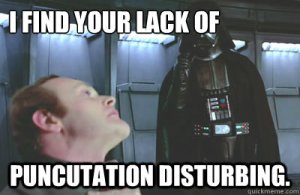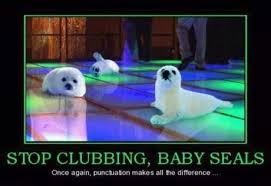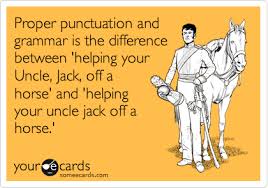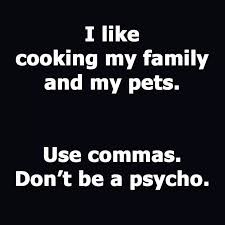 Oh punctuation, she is a harsh mistress indeed. A great equalizer, because all writers and authors are subject to the same stolid rules, no matter how successful or renowned they might be. There’s a bit of stylistic wiggle room, if you’re brave, but mostly their guidelines blanket anyone who traffics in the written word. Early on we all learn about commas, periods, periods, parentheses, colons, semi-colons, and the like. We all know the basics, where they go, and what they mean. The trouble is making them align properly in tricky situations like dialogue, and how to tweak and adjust to help the reader’s ride through your prose go easy and smooth.
Oh punctuation, she is a harsh mistress indeed. A great equalizer, because all writers and authors are subject to the same stolid rules, no matter how successful or renowned they might be. There’s a bit of stylistic wiggle room, if you’re brave, but mostly their guidelines blanket anyone who traffics in the written word. Early on we all learn about commas, periods, periods, parentheses, colons, semi-colons, and the like. We all know the basics, where they go, and what they mean. The trouble is making them align properly in tricky situations like dialogue, and how to tweak and adjust to help the reader’s ride through your prose go easy and smooth.
I’ll endeavor to address some of the issues I’ve seen more commonly, and some that I just want to address. I’m writing. You’re reading. If you want my somewhat informed opinion on any other matters of grammar, please let me know:
1) Commas, and The Oxford Comma: When you list a group of three or more things in a row, you may or may not include a comma preceding the final and (i.e The crowd was loud, raucous, boisterous, and foul-smelling). I’m not going to spark the debate. I’m not going to climb up on a soap box. The Oxford comma is listed as “optional” so that’s what it is. I choose to use it, you may not. Why is it the Oxford comma? Because it was traditionally used by the Oxford University Press.
Oxford or not, commas can be excellent pacing devices in your writing. Don’t make the mistake of running sentences on and on, or of smattering commas around willy-nilly. That will turn a reader off faster than poor spelling (or maybe just as fast). But if you’re trying to create suspense, focus in on a particular moment in the prose, or slow down the pace, don’t shy away from using commas to control the speed of your writing. It can be surprisingly effective.
2) Dialogue Punctuation: While it seems straightforward and grammatically established, properly (or even better, effectively) punctuating dialogue is a key component for any kind of writing. You must clearly depict which character is speaking, or the reader may get frustrated and confused.
The easiest way for me to break it down is into three key details (hooray, another list):
a. Treat anything the speaker says as a sentence on its own, contained within the quotations. Capitalize when you start, even if you have description or an identifier preceding the dialogue, and place all punctuation within the quotes (as long as its pertinent to what’s being said), even if you’re ending the sentence with a quotation. It’s permissible to have quotation marks hanging outside of the last period. That’s English for you.
– Felix stood up and proudly stated, “Poor bloody infantry is a state of mind.”
b. The commas make a stunning return. If you precede a line of dialogue with an identifier (as seen above), you must separate it with a comma from the text of the dialogue. If you choose to divide or pause in the middle of the dialogue, close with a comma, and then re-open with a comma. No need for a period or capitalization on the second half unless it completes a thought:
– “I don’t understand,” he said, eyebrows furrowed in confusion, “why you think a rubber chicken is ineffective for self-defense.”
Now here’s a wrinkle: If you close the sentence with a modifier outside of the quotation, then you close the quotation with a comma, even though it closes a thought:
-“I can’t believe he hit me with a rubber chicken,” he said
c. Always start a new paragraph when a new character starts speaking. This is the one I see go wrong the least…but when it goes wrong it is very noticeable. This is the easiest way to differentiate among a group of people speaking to each other, and like most punctuation it sounds simple but can be very tricky if you introduce interruptions or clipped speech.
3) Dashes, Hyphens, and Italics: Less punctuation and more stylistic, dashes and hyphens are commonly used in prose writing to indicate sudden stops (M-Dash), describe ranges (N-Dash), and helps us make fun combo-words…like combo-word (hyphen). Some standard guidelines (WordPress is not a punctuation tool, so use your imagination):
Hyphens – Connect compund words (like-minded)
N-Dash – Describes ranges (July-October)
M-Dash – Can be used like commas to separate a unique idea from the main clause of a sentence:
“Utilizing a rubber chicken—rather than mace or nunchaku—is a safer alternative.”
– Sets an inserted thought or clause apart the main clause:
“The tall man swung the rubber chicken—was he a ninja?—and the masked man stopped and stared.
– Shows when dialogue is interrupted:
“I swung the rubber chicken with all my–”
“Wait, did you say rubber chicken?”
Similar to hyphens and dashes, Italics can serve a mutlitude of purposes for an author. They can delineate internal monologue from external action, can serve as exclamation in dialogue without the use of an exclamation point, and serve to identify a “story within a story” when a character reads a letter or a journal entry, for example. But don’t over do it, or the italics will lose their power, and the reader will get annoyed. Trust me. I’ve been there.
Punctuation matters, and not just to keep people from thinking you’re a cannibal. Keep that in mind fellow writing enthusiasts. It seems easy and standardized, but the tricksy English language has twists and turns it can take a life time to master. Just don’t make any of the big errors. Because those are distracting. And a distracted reader is not a reader for very long.
Signing Off.
–



All helpful and excellent tips. I especially enjoyed the examples with the rubber chicken. lol. Can’t wait to see the next installment. 🙂
LikeLiked by 1 person
Interesting read! I have always had issues with punctuation, my English professors would often only give me B’s on my papers as I’d have too many commas and other grammar mistakes throughout to warrant an A :-b. I like the part about the dashes, never thought about their differences :).
LikeLike